
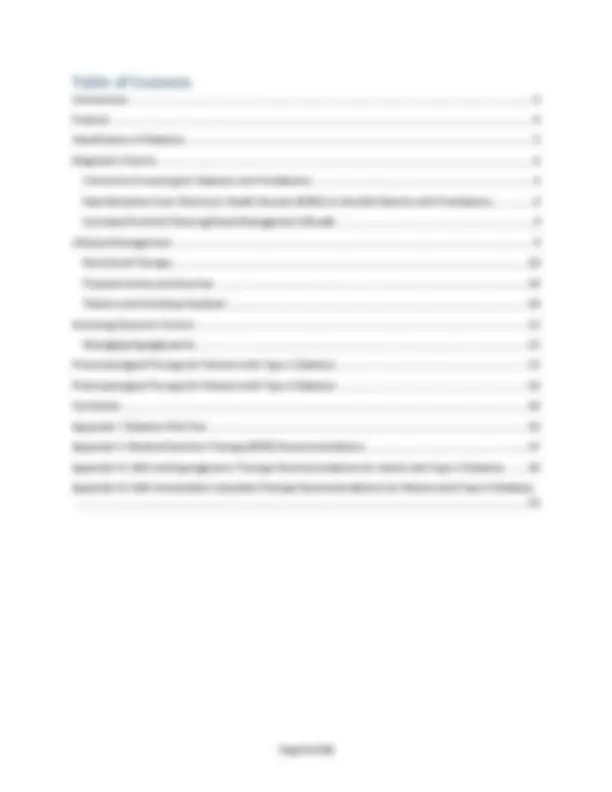
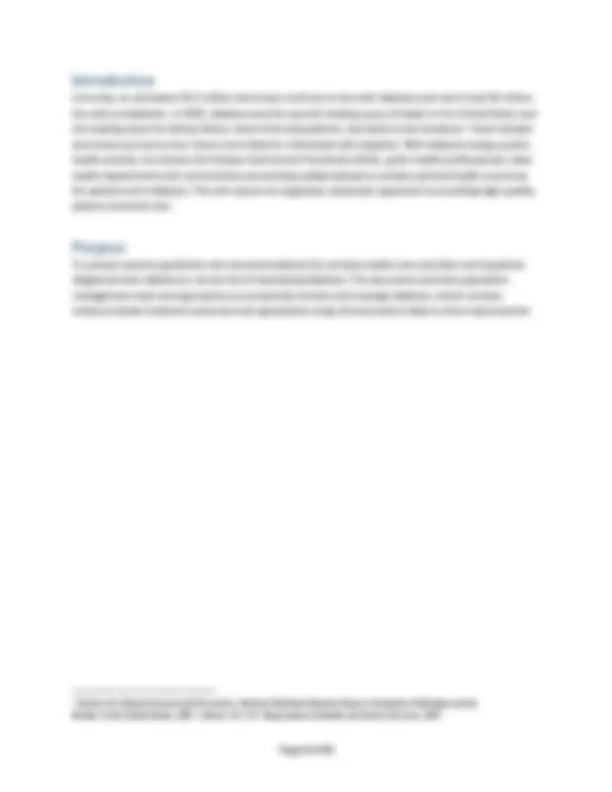
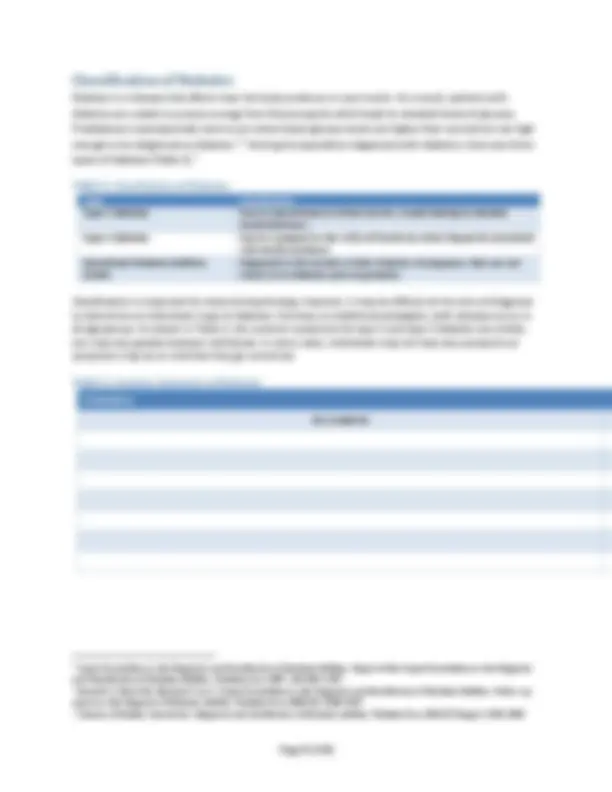
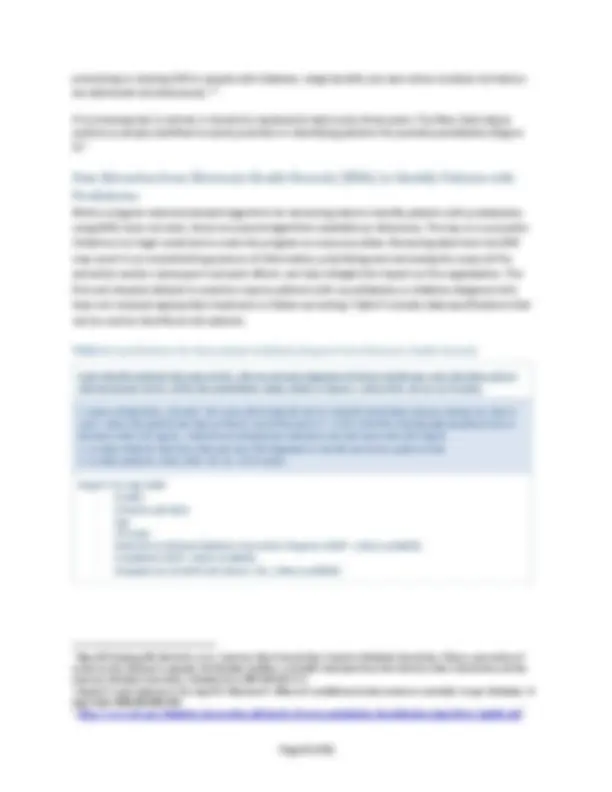
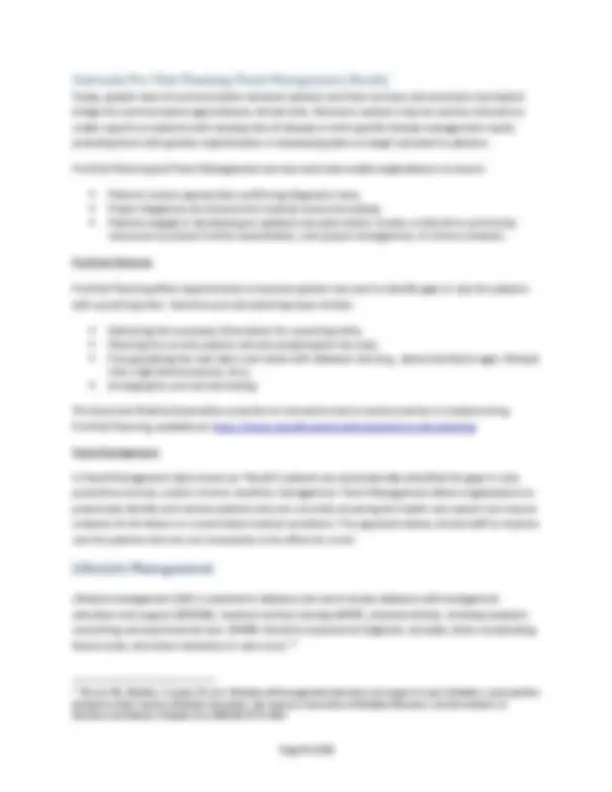
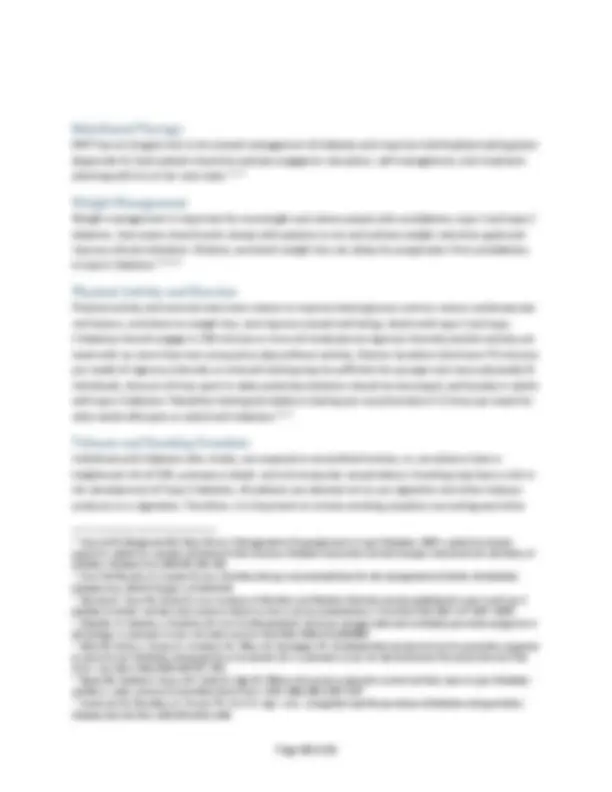
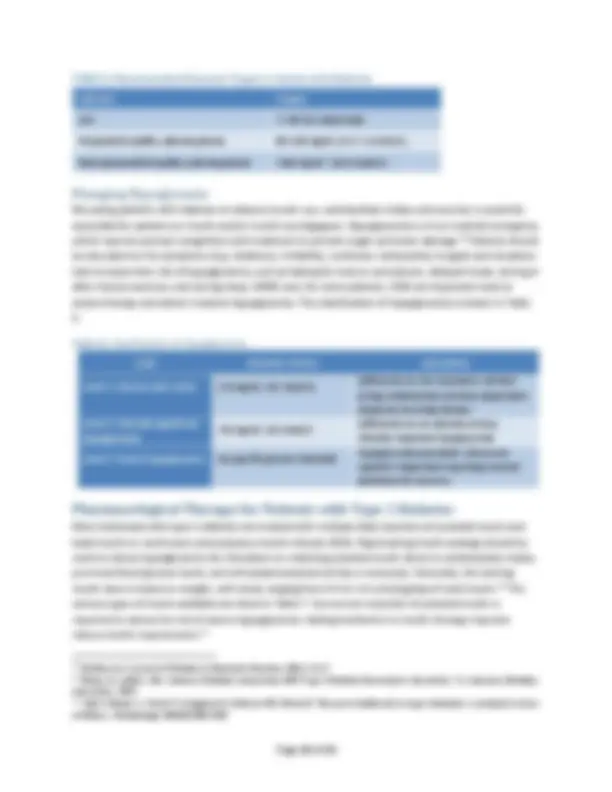
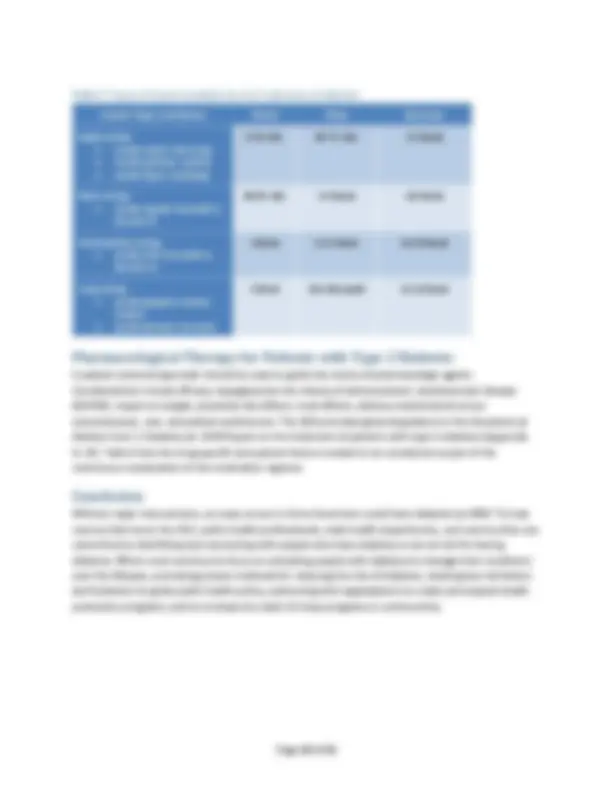
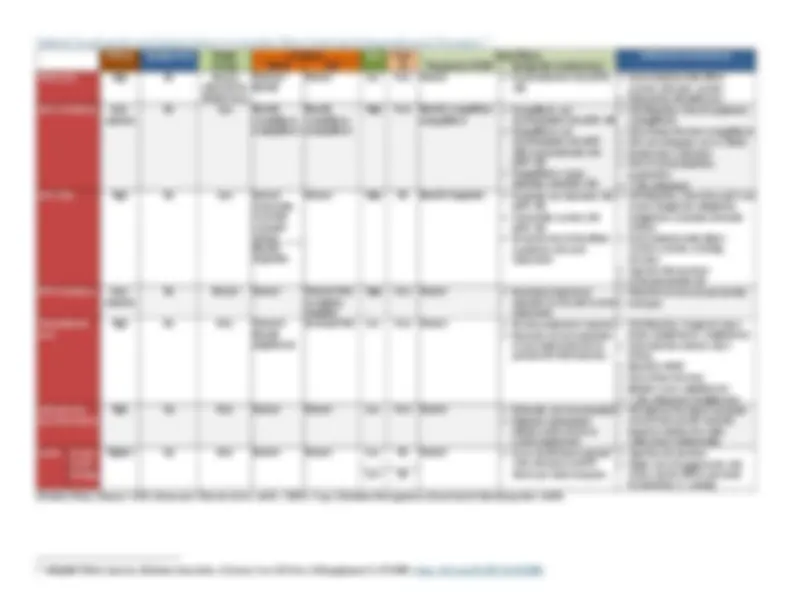

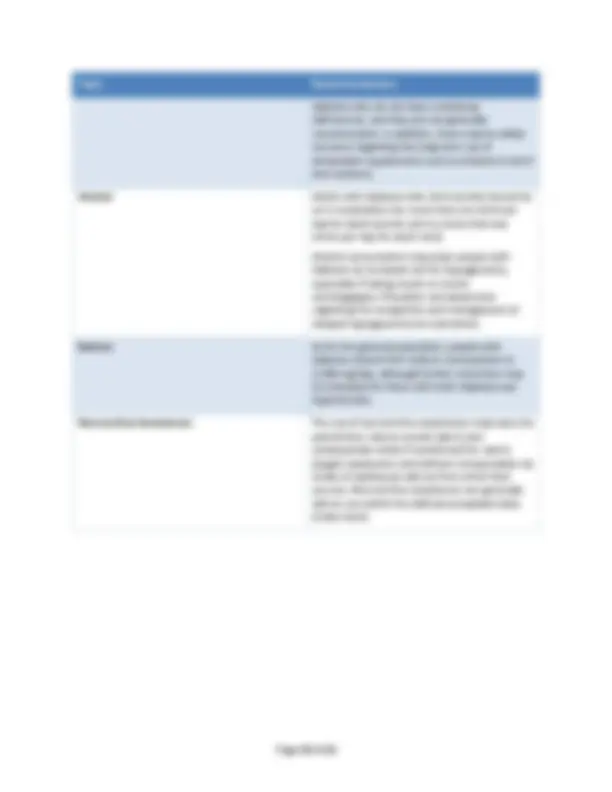
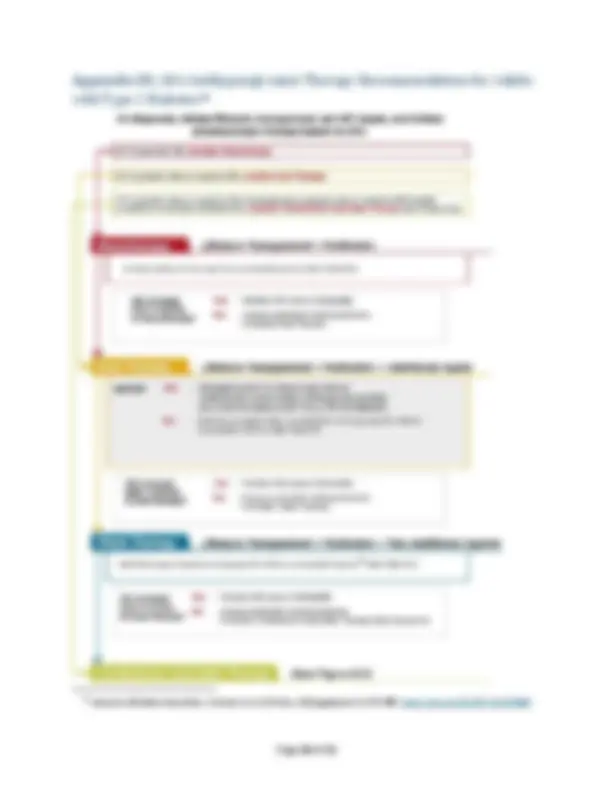
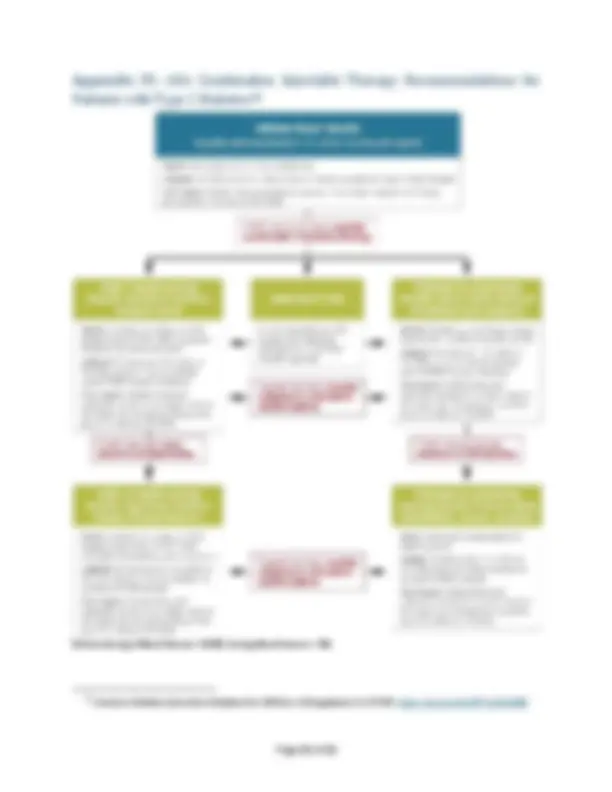


Study with the several resources on Docsity

Earn points by helping other students or get them with a premium plan


Prepare for your exams
Study with the several resources on Docsity

Earn points to download
Earn points by helping other students or get them with a premium plan
Community
Ask the community for help and clear up your study doubts
Discover the best universities in your country according to Docsity users
Free resources
Download our free guides on studying techniques, anxiety management strategies, and thesis advice from Docsity tutors
Practice guidelines and recommendations for healthcare providers to identify and manage diabetes and prediabetes in adults. It covers the classification of diabetes, screening criteria, data extraction from electronic health records, assessing glycemic control, managing hypoglycemia, and pharmacological therapy for patients with type 1 and type 2 diabetes. It also emphasizes the importance of diabetes education and prevention.
Typology: Lecture notes
1 / 21

This page cannot be seen from the preview
Don't miss anything!














We would like to extend special thanks to the following individuals for their assistance in the
development and review of this document:
Intrepid Ascent
Sokkim Lim, PharmD
John Weir, MS
Keira Armstrong, MPH
Wendy Jameson, MPP, MPH
Joshua May, BA
Mark Elson, PhD
California Department of Public Health
Chronic Disease Control Branch
Jessica Núñez de Ybarra, MD, MPH, FACPM
Alexandria Simpson, BS
Catrina Taylor, PhD, MSPH
Lauren Gernon, MPH
This publication was produced with funding from Centers for Disease Control and Prevention (CDC)
Grant Numbers DP005499 and DP004795 through the California Department of Public Health. Its
contents are solely the responsibility of the authors and do not necessarily represent the official views
of the CDC or the U.S. Department of Health and Human Services.
The content included in this report may be reproduced with the following citation:
Lim S, Weir J, Armstrong K, Jameson W, May J, Elson M (2018). Clinical Protocol for the Prevention and Treatment of Diabetes in Adults. Commissioned by the Chronic Disease Control Branch, California Department of Public Health, Sacramento, CA
May 2018
Currently, an estimated 30.3 million Americans continue to live with diabetes and more than 84 million
live with prediabetes. In 2015, diabetes was the seventh leading cause of death in the United States and
the leading cause for kidney failure, lower-limb amputations, and adult-onset blindness.^1 Heart disease
and stroke are two to four times more likely for individuals with diabetes. With diabetes being a public
health priority, the Centers for Disease Control and Prevention (CDC), public health professionals, state
health departments and communities are working collaboratively to achieve optimal health outcomes
for patients with diabetes. This will require an organized, systematic approach to providing high-quality,
patient-centered care.
To present practice guidelines and recommendations for primary health care providers serving adults
diagnosed with diabetes or are at-risk of developing diabetes. This document provides population
management tools and approaches to proactively monitor and manage diabetes, which includes
evidence-based treatment protocols and approaches using clinical practice data to drive improvement.
(^1) Centers for Disease Control and Prevention. National Diabetes Statistics Report: Estimates of Diabetes and Its
Burden in the United States, 2017. Atlanta, GA: U.S. Department of Health and Human Services; 2017.
Diabetes is a disease that affects how the body produces or uses insulin. As a result, patients with
diabetes are unable to process energy from food properly which leads to elevated levels of glucose.
Prediabetes is asymptomatic and occurs when blood glucose levels are higher than normal but not high
enough to be diagnosed as diabetes.^2 ,^3 Among the population diagnosed with diabetes, there are three
types of diabetes (Table 1).^4
TABLE 1. Classification of Diabetes
Type Classification Type 1 Diabetes Due to autoimmune β-cell destruction, usually leading to absolute insulin deficiency Type 2 Diabetes Due to a progressive loss of β-cell insulin secretion frequently associated with insulin resistance Gestational Diabetes Mellitus (GDM)
Diagnosed in the second or third trimester of pregnancy that was not clearly overt diabetes prior to gestation
Classification is important for determining therapy; however, it may be difficult at the time of diagnosis to determine an individual’s type of diabetes. Contrary to traditional paradigms, both diseases occur in all age groups. As shown in Table 2, the common symptoms for type 1 and type 2 diabetes are similar, but may vary greatly between individuals. In some cases, individuals may not have any symptoms or symptoms may be so mild that they go unnoticed.
TABLE 2. Common Symptoms of Diabetes
Prediabetes
No symptoms
(^2) Expert Committee on the Diagnosis and Classification of Diabetes Mellitus. Report of the Expert Committee on the Diagnosis
and Classification of Diabetes Mellitus. Diabetes Care 1997; 20:1183– (^3) Genuth S, Alberti KG, Bennett P, et al.; Expert Committee on the Diagnosis and Classification of Diabetes Mellitus. Follow-up report on the diagnosis of diabetes mellitus. Diabetes Care 2003;26: 3160– (^4) American Diabetes Association. Diagnosis and classification of diabetes mellitus. Diabetes Care 2014;37(Suppl. 1):S81–S
FIGURE 1. Point-of-Care Possible Prediabetes and Diabetes Identification
Screening should be performed on adults of any age who are overweight or obese, and who have one or more of the above diabetes risk factors. Assessing an individual’s history of CVD is particularly important, as it is the major cause of morbidity and mortality for individuals with diabetes. Common conditions that coexist with type 2 diabetes (e.g., hypertension and dyslipidemia) are clear risk factors for CVD. Numerous studies have shown the efficacy of controlling individual CVD risk factors in
preventing or slowing CVD in people with diabetes. Large benefits are seen when multiple risk factors are addressed simultaneously.^7 ,^8
If a screening test is normal, it should be repeated at least every three years. The flow chart above outlines a sample workflow to assist providers in identifying patients for possible prediabetes (Figure 1).^9
While a singular national standard algorithm for extracting data to identify patients with prediabetes
using EHRs does not exist, there are several algorithms available as references. The key to a successful
initiative is to begin small and to scale the program as resources allow. Extracting data from the EHR
may result in an overwhelming amount of information; prioritizing and narrowing the scope of the
extraction and/or subsequent outreach efforts can help mitigate the impact on the organization. The
first and simplest dataset to examine may be patients with a prediabetes or diabetes diagnosis who
have not received appropriate treatment or follow-up testing. Table 4 includes data specifications that
can be used to identify at-risk patients.
TABLE 4. Specifications for Generating Prediabetes Reports from Electronic Health Records
(^7) Buse JB, Ginsberg HN, Bakris GL, et al.; American Heart Association; American Diabetes Association. Primary prevention of cardiovascular diseases in people with diabetes mellitus: a scientific statement from the American Heart Association and the American Diabetes Association. Diabetes Care 2007;30:162– (^8) Gaede P, Lund-Andersen H, Parving H-H, Pedersen O. Effect of a multifactorial intervention on mortality in type 2 diabetes. N Engl J Med 2008;358:580– (^9) http://www.cdc.gov/diabetes/prevention/pdf/point-of-care-prediabetes-identification-algorithm_tag508.pdf
Goal: Identify patients between 18-85 with no previous diagnosis of DM or insulin use, but who have A1C or plasma glucose levels within the prediabetes range noted in Figure 1 with a BMI >25 (or 22 if Asian).
Report Viewing Fields
MNT has an integral role in the overall management of diabetes and requires individualized eating plans
(Appendix II). Each patient should be actively engaged in education, self-management, and treatment
planning with his or her care team.^11 ,^12
Weight management is important for overweight and obese people with prediabetes, type 1 and type 2
diabetes. Care teams should work closely with patients to set and achieve weight reduction goals and
improve clinical indicators. Modest, persistent weight loss can delay the progression from prediabetes
to type 2 diabetes.^13 ,^14 ,^15
Physical activity and exercise have been shown to improve blood glucose control, reduce cardiovascular
risk factors, contribute to weight loss, and improve overall well-being. Adults with type 1 and type
2 diabetes should engage in 150 minutes or more of moderate-to-vigorous intensity aerobic activity per
week with no more than two consecutive days without activity. Shorter durations (minimum 75 minutes
per week) of vigorous-intensity or interval training may be sufficient for younger and more physically fit
individuals. Amount of time spent in daily sedentary behavior should be decreased, particularly in adults
with type 2 diabetes. Flexibility training and balance training are recommended 2–3 times per week for
older adults (60 years or older) with diabetes.^16 ,^17
Individuals with diabetes who smoke, are exposed to secondhand smoke, or use tobacco have a
heightened risk of CVD, premature death, and microvascular complications. Smoking may have a role in
the development of Type 2 diabetes. All patients are advised not to use cigarettes and other tobacco
products or e-cigarettes. Therefore, it is important to include smoking cessation counseling and other
(^11) Inzucchi SE, Bergenstal RM, Buse JB, et al. Management of hyperglycemia in type 2 diabetes, 2015: a patient-centered approach: update to a position statement of the American Diabetes Association and the European Association for the Study of Diabetes. Diabetes Care 2015;38:140– (^12) Evert AB, Boucher JL, Cypress M, et al. Nutrition therapy recommendations for the management of adults with diabetes.
Diabetes Care 2014;37(Suppl. 1):S120–S143. (^13) MacLeod J, Franz MJ, Handu D, et al. Academy of Nutrition and Dietetics Nutrition practice guideline for type 1 and type 2
diabetes in adults: nutrition intervention evidence reviews and recommendations. J Acad Nutr Diet 2017;117:1637–1658. (^14) Mudaliar U, Zabetian A, Goodman M, et al. Cardiometabolic risk factor changes observed in diabetes prevention programs in
US settings: a systematic review and meta-analysis. PLoS Med 2016;13:e1002095. (^15) Balk EM, Earley A, Raman G, Avendano EA, Pittas AG, Remington PL. Combined diet and physical activity promotion programs
to prevent type 2 diabetes among persons at increased risk: a systematic review for the Community Preventive Services Task Force. Ann Intern Med 2015;163:437–451. (^16) Boulé NG, Haddad E, Kenny GP, Wells GA, Sigal RJ. Effects of exercise on glycemic control and body mass in type 2 diabetes mellitus: a meta-analysis of controlled clinical trials. JAMA 2001;286:1218–1227. (^17) Jankowich M, Choudhary G, Taveira TH, Wu W-C. Age-, race-, and gender-specific prevalence of diabetes among smokers.
Diabetes Res Clin Pract 2011;93:e101–e
forms of treatment as a routine component of diabetes care.^18
Patient self-monitoring of blood glucose (SMBG) and A1C, and continuous glucose monitoring (CGM),
are two methods that are often used to assess the effectiveness and safety of a diabetes management
plan.^19
The advantages of SMBG include accuracy and relatively low costs in the measurement of capillary
glucose concentrations. Glucose meters can offer features including memory, downloading software,
small blood sample requirements, and the option of no coding strips. Disadvantages include the impact
of user error on test accuracy, the need for multiple finger-stick blood samples each day, and limitations
of what clinicians can learn from a few daily snapshots of glucose concentrations.^20 ,^23
The main advantage of CGM is continuously capturing interstitial glucose concentration, which can help
identify trends and patterns in glucose control.^24 ,^25 In addition, some monitors can be programmed to
alarm for high or low glucose values, reducing fear related to the ability to detect hypo- or
hyperglycemia.^26 Disadvantages include the cost of CGM, and lack of universal insurance coverage for
this technology.
A1C reflects average glycemic level over approximately three months and has strong predictive value for
diabetes complications. The A1C test should be performed at least twice per year in patients who are
meeting treatment goals, and quarterly in patients whose therapy has changed or who are not meeting
glycemic goals.^27 The ADA and the American Association for Clinical Chemistry (AACC) have determined
that the correlation between the A1C and the estimated average glucose results is strong enough that
(^18) Akter S, Goto A, Mizoue T. Smoking and the risk of type 2 diabetes in Japan: a systematic review and meta-analysis. J
Epidemiol 2017;27:553– (^19) Aleppo G, Ruedy KJ, Riddlesworth TD, et al.; REPLACE-BG Study Group. REPLACE-BG: a randomized trial comparing
continuous glucose monitoring with and without routine blood glucose monitoring in adults with well-controlled type 1 diabetes. Diabetes Care 2017;40:538–545. (^20) Benjamin E. Self-Monitoring of Blood Glucose: The Basics. Clin Diabetes. 2002;20:45–47. (^21) 2008 resource guide. Blood glucose monitoring and data management systems. Before you buy a blood glucose monitor (also known as a blood glucose meter), check with your doctor and diabetes educator. Make sure the one you choose is well suited to your particular needs. Diabetes Forecast. 2008;61:RG31–RG32. RG34–RG48. (^22) Bode BW. The Accuracy and Interferences in Self-monitoring of Blood Glucose. US Endocrine Disease. 2007:46–48. (^23) Le Floch JP, Bauduceau B, Levy M, Mosnier-Pudar H, Sachon C, Kakou B. Self-monitoring of blood glucose, cutaneous finger
injury, and sensory loss in diabetic patients. Diabetes Care. 2008;31:e73. (^24) Wadwa RP, Fiallo-Scharer R, Vanderwel B, Messer LH, Cobry E, Chase HP. Continuous glucose monitoring in youth with type 1
diabetes. Diabetes Technol Ther. 2009;11(Suppl 1):S83–S91. (^25) Nardacci EA, Bode BW, Hirsch IB. Individualizing care for the many: the evolving role of professional continuous glucose monitoring systems in clinical practice. Diabetes Educ. 2010;36(Suppl 1):4S–19S. quiz 20S–21S. (^26) Hirsch IB, Abelseth J, Bode BW, Fischer JS, Kaufman FR, Mastrototaro J, Parkin CG, Wolpert HA, Buckingham BA. Sensor- augmented insulin pump therapy: results of the first randomized treat-to-target study. Diabetes Technol Ther. 2008;10:377– (^27) Jovanovič L, Savas H, Mehta M, Trujillo A, Pettitt DJ. Frequent monitoring of A1C during pregnancy as a treatment tool to
guide therapy. Diabetes Care 2011;34:53–
TABLE 5. Recommended Glycemic Targets in Adults with Diabetes
Indicator Targets
A1C <7.0% (53 mmol/mol)
Preprandial capillary plasma glucose 80–130 mg/dL (4.4–7.2 mmol/L)
Peak postprandial capillary plasma glucose <180 mg/dL*^ (10.0 mmol/L)
Educating patients with diabetes to balance insulin use, carbohydrate intake and exercise is essential,
especially for patients on insulin and/or insulin secretgogues. Hypoglycemia is a true medical emergency
which requires prompt recognition and treatment to prevent organ and brain damage.^29 Patients should
be educated on the symptoms (e.g. shakiness, irritability, confusion, tachycardia, hunger) and situations
that increase their risk of hypoglycemia, such as fasting for tests or procedures, delayed meals, during or
after intense exercise, and during sleep. SMBG and, for some patients, CGM are important tools to
assess therapy and detect incipient hypoglycemia. The classification of hypoglycemia is shown in Table
Table 6. Classification of Hypoglycemia
Level Glycemic Criteria Description
Level 1: Glucose alert value ≤70 mg/dL (3.9 mmol/L) Sufficiently low for treatment with fast- acting carbohydrate and dose adjustment of glucose-lowering therapy Level 2: Clinically significant hypoglycemia
<54 mg/dL (3.0 mmol/L Sufficiently low to indicate serious, clinically important hypoglycemia
Level 3: Severe hypoglycemia No specific glucose threshold Hypoglycemia associated with severe cognitive impairment requiring external assistance for recovery
Most individuals with type 1 diabetes are treated with multiple daily injections of prandial insulin and
basal insulin or continuous subcutaneous insulin infusion (CSII). Rapid-acting insulin analogs should be
used to reduce hypoglycemia risk. Education on matching prandial insulin doses to carbohydrate intake,
pre-meal blood glucose levels, and anticipated physical activity is necessary. Generally, the starting
insulin dose is based on weight, with doses ranging from 0.4 to 1.0 units/kg/day of total insulin.^30 The
various types of insulin available are listed in Table 7. Concurrent reduction of prandial insulin is
required to reduce the risk of severe hypoglycemia. Adding metformin to insulin therapy may also
reduce insulin requirements.^31
(^29) Shafiee et al. Journal of Diabetes & Metabolic Disorders 2012, 11: (^30) Peters AL, Laffel L, Eds. American Diabetes Association/JDRF Type 1 Diabetes Sourcebook. Alexandria, VA, American Diabetes Association, 2013 (^31) Vella S, Buetow L, Royle P, Livingstone S, Colhoun HM, Petrie JR. The use of metformin in type 1 diabetes: a systematic review
of efficacy. Diabetologia 2010;53:809–
Table 7. Types of Insulin Available for the Treatment of Diabetes
Insulin Type and Name Onset Peak Duration
Rapid-acting
5-15 min. 45-75 min. 3-4 hours
Short-acting
30-45 min. 2-4 hours 6-8 hours
Intermediate-acting
2 hours 4-12 hours 16-24 hours
Long-acting
2 hours No clear peak 14 - 24 hours
A patient-centered approach should be used to guide the choice of pharmacologic agents.
Considerations include efficacy, hypoglycemia risk, history of atherosclerotic cardiovascular disease
(ASCVD), impact on weight, potential side effects, renal effects, delivery method (oral versus
subcutaneous), cost, and patient preferences. The ADA provided general guidance in the Standards of
Medical Care in Diabetes for 2018 Report on the treatment of patients with type 2 diabetes (Appendix
III, IV). Table 8 lists the drug-specific and patient factors needed to be considered as part of the
continuous reevaluation of the medication regimen.
Without major interventions, as many as one in three Americans could have diabetes by 2050. To help
reverse that trend, the CDC, public health professionals, state health departments, and communities are
committed to identifying and connecting with people who have diabetes or are at-risk for having
diabetes. Efforts must continue to focus on educating people with diabetes to manage their conditions
over the lifespan, promoting proven methods for reducing the risk of diabetes, tracking key risk factors
and behaviors to guide public health policy, partnering with organizations to create and expand health
promotion programs, and to increase the reach of these programs in communities.
Topic Recommendations
Effectiveness of Nutrition Therapy An individualized MNT program, preferably provided by a registered dietitian, is recommended for all people with type 1 or type 2 diabetes, or gestational diabetes mellitus.
A simple and effective approach to glycemia and weight management emphasizing portion control and healthy food choices may be considered for those with type 2 diabetes who are not taking insulin, who have limited health literacy or numeracy, or who are older and prone to hypoglycemia.
Because diabetes nutrition therapy can result in cost savings and improved outcomes (e.g., A1C reduction), MNT is typically reimbursed by insurance and other payers.
Energy Balance Weight loss (5 percent) achievable by the combination of reduction of calorie intake and lifestyle modification benefits overweight or obese adults with type 2 diabetes and those with prediabetes. Intervention programs to facilitate weight loss are recommended.
Eating Patterns and Macronutrient Distribution There is no single ideal dietary distribution of calories among carbohydrates, fats, and proteins for people with diabetes; therefore, macronutrient distribution should be individualized while keeping total calorie and metabolic goals in mind. A variety of eating patterns are acceptable for the management of type 2 diabetes and prediabetes.
Carbohydrates Carbohydrate intake from vegetables, fruits, legumes, whole grains, and dairy products, with an emphasis on foods higher in fiber and lower in glycemic load, is preferred over other sources, especially those containing added sugars.
(^33) Evert AB, Boucher JL, Cypress M, et al. Nutrition therapy recommendations for the management of adults with
diabetes. Diabetes Care 2014;37(Suppl. 1):S120–S143.
Topic Recommendations
diabetes who do not have underlying deficiencies, and they are not generally recommended. In addition, there may be safety concerns regarding the long-term use of antioxidant supplements such as vitamins E and C and carotene.
Alcohol Adults with diabetes who drink alcohol should do so in moderation (no more than one drink per day for adult women and no more than two drinks per day for adult men).
Alcohol consumption may place people with diabetes at increased risk for hypoglycemia, especially if taking insulin or insulin secretagogues. Education and awareness regarding the recognition and management of delayed hypoglycemia are warranted.
Sodium As for the general population, people with diabetes should limit sodium consumption to 2,300 mg/day, although further restriction may be indicated for those with both diabetes and hypertension.
Nonnutritive Sweeteners The use of nonnutritive sweeteners may have the potential to reduce overall calorie and carbohydrate intake if substituted for caloric (sugar) sweeteners and without compensation by intake of additional calories from other food sources. Nonnutritive sweeteners are generally safe to use within the defined acceptable daily intake levels.
(^34) American Diabetes Association. Diabetes Care 2018 Jan; 41(Supplement 1): S73-S85. https://doi.org/10.2337/dc18-S